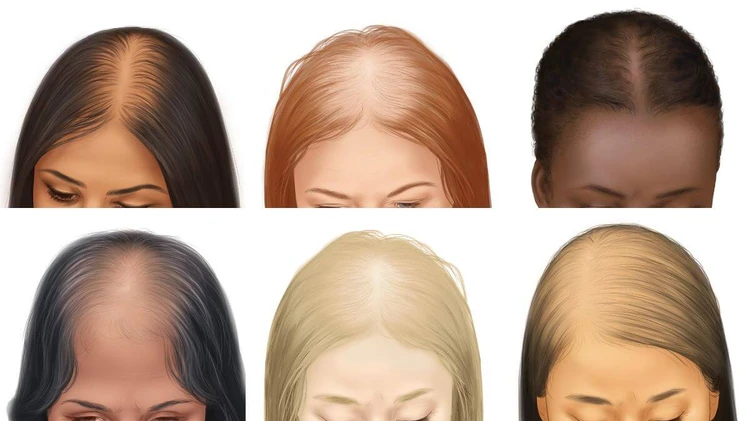Hair loss can be one side effect of menopause. Let’s take a look at what causes it and how to reverse thinning hair after menopause.
If you’re experiencing postmenopausal hair loss, you’re not alone.
Over half of postmenopausal women deal with thinning hair and bald patches.
Let’s talk about what causes postmenopausal hair loss, what vitamins are good for hair loss during menopause, and how to make thinning hair grow back.
In this article: 📝
- How to reverse thinning hair after menopause?
- How to thicken hair after menopause?
- How to stop menopausal hair loss
How to reverse thinning hair after menopause?
Step one is to ensure your hair loss is actually due to menopause.
There’s a good chance your hair loss is due to menopause if:
- It’s been over twelve months since your last period, and
- Your hair loss follows a female hair loss pattern (meaning your part appears to be getting wider, as opposed to a receding hairline in the front.)
It’s always a good idea to check with your doctor, though.
Your hair loss might be related to other factors, like an underlying illness, hormone imbalance, or vitamin deficiency, rather than menopause.
But menopause and hair loss do go hand in hand.

The hormone fluctuations at this time of life can do two things:
- Make your hair strands thinner and
- Disrupt the hair growth cycle, so that hair falls out faster than new growth can catch up.
So, if your hair loss is caused by menopause, is there anything you can do about it?
Let’s take a look.👇
How to thicken hair after menopause?
If you’re searching for thicker hair after menopause, there are various treatments you can try, from medications to different styling techniques.
Some basic health habits, like stress management and nutrition, can also help.
Read on for the low down on some specific treatments to try:
1. Taking vitamins for thinning hair menopause 💊
A good place to start when dealing with thinning hair after menopause is your diet and supplement intake.
You can ask your doctor to check your blood levels of zinc, iron, and vitamin B.
These all play a role in hair health.
If you’re deficient in any of these vitamins, consider taking a multivitamin formulated for menopause.
You can also up your intake of eggs, legumes, nuts, and seeds.
These are all great sources of biotin, a B vitamin that’s really important for hair health.
A 2017 study even showed promising signs that biotin for menopausal hair loss could promote regrowth.
2. Reducing stress 🧘♀️
It’s also important to consider your stress levels.
Menopause is often a stressful time for so many reasons, from hormones to career and family issues.
And stress can play a big role in hair loss.
If your life feels unusually stressful right now, try talking to a doctor or therapist about ways you can bring some more calm back to your life.
A basic five-minute daily meditation might be a good place to start.
It’s also a good idea to cut down or eliminate drinking and smoking, as these can also both contribute to poor hair health.
3. Switching up your hair care for menopause 💇♀️
The final simple intervention to try is different styling techniques.
These can help prevent future hair loss and disguise any existing hair loss or hair texture change after menopause.
First, be gentle when shampooing and brushing your hair.
Then, see if parting your hair in a different direction helps disguise the thinning areas.
There are even hair stylists who specialize in thinning hair.
It’s possible that a different haircut can change up your look and make hair loss less visible.
That may include cutting off thinning hair ends.
Okay, so we’ve talked about nutrition, lifestyle, and hair styling—but what if you’ve tried all of these, and your hair loss is still an issue for you?
Let’s look at some other treatments.
How to stop menopausal hair loss
There are some medical treatments that can help hair growth after menopause.
From topicals to oral medications to hair transplants, there’s lots of hope available for reversing thinning hair after menopause.
Rogaine, including its generic versions, is definitely an option, though it can take several months to see results.
You can also try an oral medication called spironolactone, which a doctor can prescribe off-license for hair loss.
Platelet-rich plasma, or PRP (aka “the vampire facial”), which can stimulate more growth in your scalp, is also an option but the feasibility of this treatment type is still being researched so maybe one for the future.
And there are also laser therapies like low-level laser therapy that can help with hair loss.
If you’re interested in post-menopausal hair loss treatment, your first stop will probably be the dermatologist’s office to get their advice on your options.
Finally, hair transplant surgery is an option.
This can be costly and includes the usual risks of surgery.
But if you need to bring out the big guns for your hair loss, this could be a good method to try.
Again, this is one that you’d want to discuss with a dermatologist.
If you’re looking to connect with other women going through menopause, check out our Peanut menopause community.
There can be a lot of twists and turns in menopause—hair loss included— but you don’t have to go through it alone.

